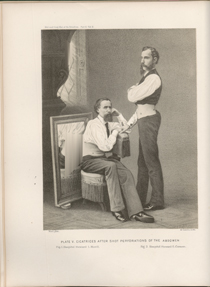Title: Morell, Louis
Source text: The Medical and Surgical History of the War of the Rebellion. (1861-65.), Part 2, Volume 2 (Washington, DC: Government Printing Office, 1876), 80-81.
Civil War Washington ID: med.d2e31589
TEI/XML: med.d2e31589.xml
CASE 243.—Sergeant Louis Morell, Co. D, 119th New York, aged 19 years, on the afternoon of July 1, 1863, in the assault on the lines of the Eleventh Corps, received two wounds, and, falling, and remaining on the field between two fires, a third wound. The first wound was from a small ball, which lodged in the globe of the left eye; the second was inflicted an instant afterward by a musket-ball, which entered four inches to the right of the umbilicus, passed directly through the body, and emerged near the right sacro-iliac synchondrosis, having grooved the crest of the innominatum. The sergeant was then in the act of reloading, the right arm elevated to use the ramrod. He recollected seeing his cartridge-box torn by the missile, and the next instant fell unconscious. He dimly recalls a temporary return of consciousness, on being struck soon afterward in the left thigh, by a musket-ball, which passed through the quadriceps extensor, a little above the patella. He remained on the field until the morning of July 4th, without suffering from hunger or thirst. He had an indistinct impression that some one had given him water and had washed the wounds on his head and thigh; the wound in the flank appeared to have escaped notice. On July 4th, he was placed in an ambulance wagon and carried to a neighboring farm house, suffering great torture in the long ride. Arrived at the farm house, his wounds were dressed by a Confederate surgeon on duty there, and he drank a little gruel, portions of which escaped by the posterior wound almost as fast as it was swallowed. The sergeant is positive that, on this and subsequent occasions, an interval of not more than half an hour elapsed between the ingestion of liquids and their escape by the posterior wound. The appearance of the clothing indicated that there had been copious hæmorrhage. Beyond this, the sergeant says, his recollections are very confused and indefinite. Probably he was under the influence of opiates. On July 8th he was taken to the Eleventh Corps field hospital, suffering again acutely in moving. No record appears here. On August 6th the patient was again moved to the Camp Letterman Hospital, and was under the immediate charge of Acting Assistant Surgeon James A. Newcombe, in the division in charge of Acting Assistant Surgeon A. B. Stonelake. The case is here registered as "a penetrating shot wound of the abdomen, loss of left eye, knee contracted." There had been a fæcal discharge from the posterior wound, but it ceased about July 12th. Getting drenched with rain one night at the field hospital, the wound near the left knee became very painful, and the limb was semi-flexed and could not be again extended. At Camp Letterman, the discharges from the abdominal wounds were purulent. On October 30th, Dr. Stonelake enlarged the posterior wound and removed a considerable fragment of wing of the ilium, perforated by the ball. On October 31st, the wounded man was sent, under care of Acting Assistant Surgeon Newcombe, to New York, and entered Ladies Home Hospital. At that time he had no fever and suffered very little pain; his bowels were uniformly regular and his health quite good. The anterior wound had healed, but the posterior wound was still open. After the journey to New York there were slight discharges of fæcal matter, at long intervals, by the posterior wound. In February, 1864, the patient began to leave his bed, and then the stercoral discharge from the fistulous became more copious. In May, Morell moved about on crutches. The flesh wound in the thigh had nearly healed; but a succession of abscesses had formed, and there was much contraction about the joint. In December, 1864, the hamstring tendons were divided by Surgeon A. B. Mott, U. S. V., and the limb was extended and placed in a useful position. While the patient was continued to his bed, after his operation, the stercoral fistula closed. May 30, 1865, the patient on the closure of Ladies' Home Hospital, was sent to MacDougal Hospital, at Fort Schuyler. The fæcal fistula reopened in June, but soon dosed again. On August 18th, Morell was discharged from service and pensioned.¹ Assistant Surgeon Samuel H. Orton, U. S. A., signed the certificate of disability, referring to the shot wounds through the abdomen and left thigh, and the loss of the left eye. July 28, 1866, Pension Examiner A. L. Lowell reports that the exit wound was still open and discharging, and that exfoliations from the ilium still continued. The fistula again closed, and, on May 11, 1867, Morell re-entered the service as a hospital steward, and was assigned to clerical duty in the Division of Surgical Records, of the Surgeon General's Office, where he is still employed. A photograph, showing the cicatrices of entrance and exit, was made at the Museum in March, 1873, and is accurately copied in the left hand or sitting figure in PLATE V.
¹ Notes of this case have been printed in the American Medical Times, 1864, Vol. VIII, pp. 13, 301, and by Dr. F. H. HAMILTON (Treatise on Mil. Surg., p. 350).
